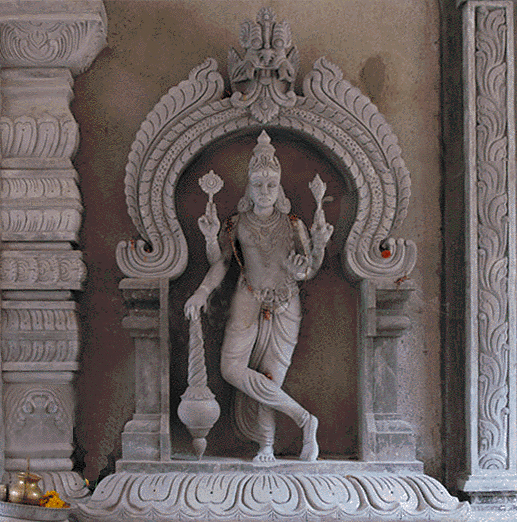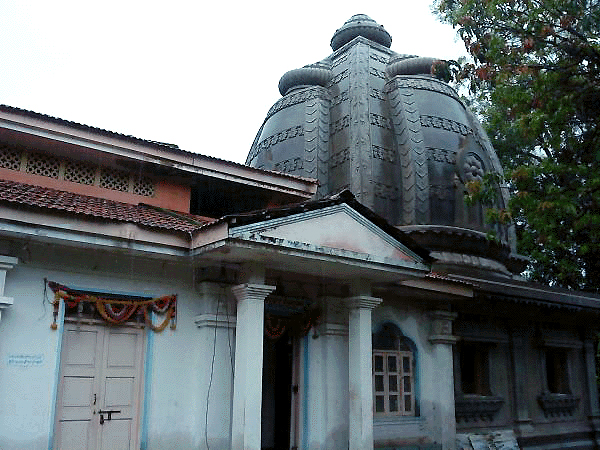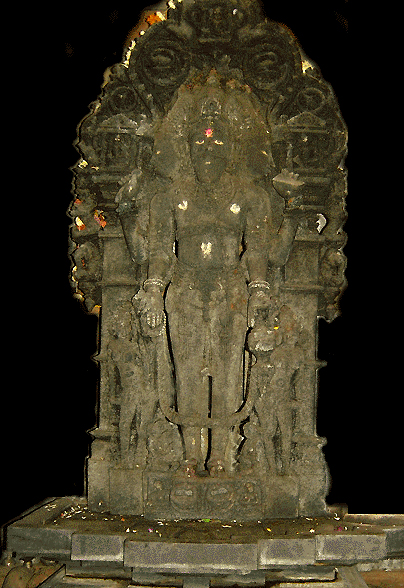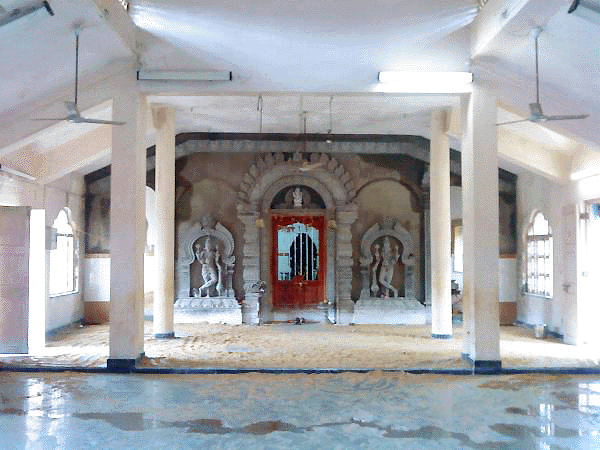Worship of Lord Brahma
BY: SUN STAFF

Brahma Temple at Carambolin
Aug 05, CANADA (SUN) — A serial exploration of places of Lord Brahma's worship.
Although Brahma is one of the most elevated transcendental personalities, being the first jiva-tatta born from the lotus flower of Garbhodakasayi Visnu, and is an expansion of Lord Balarama known as Hiranyagarbha, there are surprisingly few temples dedicated to His worship. In fact, there is a fair bit of confusion about how many temples exist in India with Lord Brahma is the presiding Deity. We find many references to their being only one, or two such temples in all of India, but as we will describe in this series, there are several Lord Brahma temples, and numerous predominant shrines or murtis for the worship of Brahma.
Amongst the thousands and thousands of temples in India dedicated to the worship of Lord Visnu and Shiva, among the very few consecrated to the worship of Brahmdev are the Brahma-Karmali in Valpoi, Goa, and the Sri Brahma temple in Pushkar, Rajasthan. Among the other notable examples we'll explore in the days ahead are Brahma temples and shrines in Jammu, Tamil Nadu, Trichy, Gujarat, Solapur, Khajurao, and elsewhere in Rajasthan.
Outside of India, Lord Brahma is most famously worshiped as the presiding Deity, along with the other members of the Trimurti, at numerous 12th century temples and shrines in Angkor Wat, Cambodia. And in Bangkok, Thailand, there is the world-famous Thao Maha Brahma, or Phra Phrom Erawan shrine, which was recently refurbished after being attacked.
There are numerous stories which explain why Lord Brahma is not offered worship in India, but we have not found conclusive evidence in sastra to support them. There are several renditions of stories in which some misunderstanding took place between Lord Brahma and Lord Shiva, which resulted in Lord Brahma being cursed. There are also stories of a dispute between Lord Brahma and the great prajapati, Brahmarishi Bhrigu, who is said to have cursed Brahma by saying that no person on Earth would ever invoke him or worship him again. It's said that the curse was made because Lord Brahma, being distracted by Saraswati's beautiful music, did not answer Bhrigu Rsi's call of invitation to a great yajna.
We begin the journey today in the western state of Goa, India, which is home to one of the most well known of all Brahma temples.

Brahma Temple at Carambolin
Lord Brahma Temple, Valpoi, Goa
A beautiful Lord Brahma temple is located in the village of Brahma Carambolim (or Kormoli) in the Satari taluka, 7 kilometers from Valpoi, Goa. The main Brahma temple is described as being situated in the Brahma-Carambolim village, which distinguishes it from Carambolim Village proper, near Old Goa, Tiswadi taluka, where the Deity originally resided. After the arrival of the Portuguese, who brought the Christian influence to Goa, the original Brahma temple was sacked, thus the Deity was moved to a safer location.
Valpoi is a densely forested area famous for its spice farms, caju (cashew) plantations and other agricultural and forest produce, but it is the presence of Lord Brahma that brings many pilgrims here. The temple was built in the 5th century, although the Deity of Lord Brahma was installed much later. The Deity was brought to Kormoli by a large contingent of devotees, who went there to escape religious persecution in the 11th century.
Beside the main Brahma temple in Carambolim, there are a number of subsidiary Brahma
shrines throughout Goa. Lord Brahma is a parivar devata in Shri Bhagavati temple in Parsem (Pednem taluka, at Virnode temple in Pedne taluk, and at Shri Shantadurga temple in Colomba (Sanguem taluka). The original ancient Deity from Colomba is now housed at the Goa State Museum in Panjim. Another murti, a head of Lord Brahma from the 8th-9th century, may be seen at the Old Goa museum. The worship of Lord Brahma appears to have arrived in this region during the period of the early Chalukyas of Badami.

Deity at Brahma-Karmali (Carambolin)
The Deity form of Brahma in the Brahma-Karmali temple is truly magnificent. Carved from a single piece of black basalt, it is one of the finest examples of ancient Kadamba art. Brahma has a beard on the central face, which the other faces are clean-shaven. He holds a ladle in his upper right hand, the Vedas in his upper left hand, Kamandalu in his lower left hand, and mala beads in his lower right hand, which is in Varamudra posture.
The temple at Brahma-Caramboli is a small plain building, not prominently recognisable as a temple. The building underwent significant renovations over the last few years, getting a fresh temple exterior and refurbishment of the interior garbagriha.

Brahma Temple at Carambolin

The Sun
News
Editorials
Features
Sun Blogs
Classifieds
Events
Recipes
PodCasts
About
Submit an Article
Contact Us
Advertise
HareKrsna.com
Copyright 2005, HareKrsna.com. All rights reserved.
